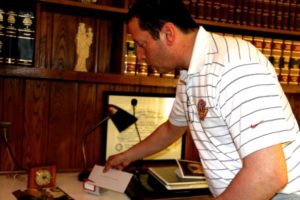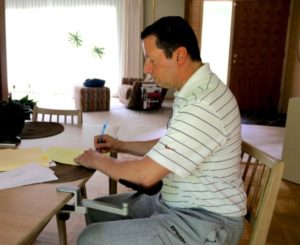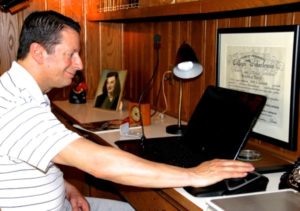 I traveled to Victor Melchiorre’s home to meet with him and learn about the assistive technology services he received at Easter Seals Crossroads. When I first walked into Victor’s home, I commented that I loved his mid-century modern home and I learned that he has a love for mid-century design, as I do. Victor was so welcoming and gave me a tour of all the great mid-century pieces that he has in his home. He told me that much of the furniture had been handed down to him from his mother. I really enjoyed talking with Victor about our mutual appreciation of this era in architectural and furniture design.
I traveled to Victor Melchiorre’s home to meet with him and learn about the assistive technology services he received at Easter Seals Crossroads. When I first walked into Victor’s home, I commented that I loved his mid-century modern home and I learned that he has a love for mid-century design, as I do. Victor was so welcoming and gave me a tour of all the great mid-century pieces that he has in his home. He told me that much of the furniture had been handed down to him from his mother. I really enjoyed talking with Victor about our mutual appreciation of this era in architectural and furniture design.
After we talked design, I started to learn more about Victor and how he became involved in our Assistive Technology program. I learned that Victor graduated Wabash College in 1977 and then graduated from Cumberland Law School in 1980. Victor practiced law in Mishawaka after graduating. In 1987, he decided to work for Midwest Commerce Banking Company, a subsidiary of NBD Bancorp. In 1993, NDB acquired the Indiana National Bank and Victor transferred to Indianapolis to work in INB’s Trust Department. After a series of subsequent bank mergers, INB ultimately became part of the firm of JPMorgan Chase and company where Victor works today in the Private Bank as a Fiduciary Specialist.
In January 2015, Victor had a stroke. The stroke affected the left side of his body and left him not being able to walk. Victor was in St. Vincent hospital for a month and then transitioned to outpatient rehabilitation therapy with Rehabilitation Hospital of Indiana (RHI) until he was discharged from all therapies in February of 2016. While he was receiving physical therapy, he was using a wheelchair to get around. He then started using a cane and now can walk independently. He is still continuing therapy with a physical therapist at Lifetime Fitness. The fitness instructor he is working with is using a technique called Muscle Activation Techniques (MAT) which is a rehabilitation technique developed for the Denver Broncos. Victor explained to me that his therapist “looks for what muscles are weak and provides palpitations to that muscle.” He told me that acupuncture has also been helpful in his recovery. He indicates that the acupuncture has helped increase the muscle strength in his face so his face is not drooping as much as it had when he first had his stroke. He said that acupuncture is also helpful for the headaches he often gets since having his stroke.
I learned that Victor was unable to work for a year while he was in recovery. He told me that while he was at RHI he was referred to work with a vocational rehabilitation facilitator whose job was to determine his needs for when he was able to return to work. The facilitator suggested he have an assistive technology evaluation to determine what equipment might be available to help him return to work and made a referral to Easter Seals Crossroads for an assistive technology evaluation. Victor was then assigned to work with David Frye. David Frye is an Assistive Technology Specialist at Easter Seals Crossroads.
To determine what assistive technology would be helpful for Victor, David  visited his home and office to learn what barriers Victor had in completing tasks. He learned that Victor had weakness in his left arm and hand. He suggested several things to help Victor do tasks with paper such as a one-handed letter opener and arm and hand rests to give him support when he needed to write. Victor told me, “It was the simple things that I could not do as well anymore that frustrated me, like opening a letter. The one-handed letter opener and arm braces took away some of the frustration. Before I had the letter opener I had to use my mouth to try and open a letter.” Since Victor is left-handed and the stroke affected his left side, it has been difficult for him to write or type. David showed him other
visited his home and office to learn what barriers Victor had in completing tasks. He learned that Victor had weakness in his left arm and hand. He suggested several things to help Victor do tasks with paper such as a one-handed letter opener and arm and hand rests to give him support when he needed to write. Victor told me, “It was the simple things that I could not do as well anymore that frustrated me, like opening a letter. The one-handed letter opener and arm braces took away some of the frustration. Before I had the letter opener I had to use my mouth to try and open a letter.” Since Victor is left-handed and the stroke affected his left side, it has been difficult for him to write or type. David showed him other  technologies that could help him do these tasks much easier. One was a smart pen, which is a pen with a voice recorder and camera. It will record everything you hear so you can write less because the voice recorder will capture everything that is said out loud. The camera is synched with the writing on the paper. Wherever you write anything with the smart pen, you can go back to that spot and put the pen on that area to hear the information that was recorded at that exact location. David also recommended Dragon Dictate, which allows a user to use voice input to dictate and transcribe data into a computer.
technologies that could help him do these tasks much easier. One was a smart pen, which is a pen with a voice recorder and camera. It will record everything you hear so you can write less because the voice recorder will capture everything that is said out loud. The camera is synched with the writing on the paper. Wherever you write anything with the smart pen, you can go back to that spot and put the pen on that area to hear the information that was recorded at that exact location. David also recommended Dragon Dictate, which allows a user to use voice input to dictate and transcribe data into a computer.
Victor discussed other ideas they worked on that helped him be more  productive such as, putting documents in a template format that he would then only have to make minor changes to instead of retyping an entire document. David also recommended a track ball mouse, which Victor says he can position the cursor much more effectively with this mouse.
productive such as, putting documents in a template format that he would then only have to make minor changes to instead of retyping an entire document. David also recommended a track ball mouse, which Victor says he can position the cursor much more effectively with this mouse.
Victor told me that he had no idea that any of these resources and devices existed before working with David. He told me, “The hardest thing for me was to admit that I could not do things on my own”. I was always very independent and had the mentality of always figuring things out on my own. Victor told me that during his recovery one of his doctors told him, “People who are successful ask for help and are willing to receive help.” Victor said this process taught him how to ask and receive help and to also be an advocate for his own recovery.
Victor expressed that one of the most exciting parts of his recovery was learning to drive again. He did the Return to Drive program last summer at RHI. Once he graduated from that program, Vocational Rehabilitation covered the expenses of modifying his vehicle and purchasing him an electric scooter and a lift for his vehicle to be able to take the scooter when he needs to go long distances. His vehicle has been modified to have a knob on the steering wheel so he can better steer and the turn signal has been installed on the right side where Victor has full function. Victor told me, “I just hated not being able to drive. Once the lift was on the car I felt such a sense of freedom.”
I asked Victor if he had any advice for anyone who is faced with the challenges he has had over the past year and he told me that he would advise anyone to be a self advocate and ask themselves, “what can I do to help myself?” He told me, “I continue to ask myself this question. I don’t leave anything untried that might make things easier for me.” He went on to tell me how valuable all the services he has received have been in enabling him to get back to living in his own home. He told me once he got back home, “I had the confidence that I was going to get better.” He told me he could not say enough positive things about his employer. He said, “people often vilify big corporations as uncaring, but JPMorgan and my work colleagues sustained me throughout my ordeal.” He told me they kept his job open for him for a year while he recovered and his office looked exactly the way he had left it right before his stroke. His co-workers even got a collection of books for him to read while he was recovering. Victor is now back at work and almost working full time hours. He told me that all of the assistive technology that David exposed him to was essential to letting him get back to work and being able to perform his job duties. He told me that David was very patient and knowledgeable about different technologies, which has allowed him to do things he was not certain he would be able to do again.
It’s was a great experience for me to learn about Victor’s journey. I was amazed at how much he has accomplished in his year and a half of recovery. His determination and hard-work coupled with some assistive technology have allowed him to return to work and live independently. We wish Victor continued success in everything he does!

